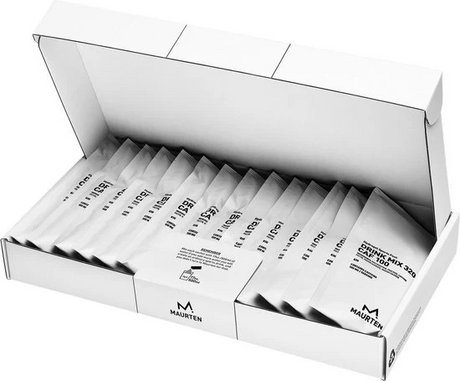So, what are the best energy gels for your next trail run or ultra?

Table of contents
You all know that feeling of running out of energy during your run. It's not always easy to keep eating. Or you think you can easily run 20 kilometers without food today (like I did yesterday ;)).
Whether you're running a short 15km trail or a 100km ultramarathon, maintaining your energy levels is crucial if you want to reach the finish line. Energy gels are a popular choice, as energy bars can be difficult to consume (especially on hot days).
But why are they so important? What exactly do carbohydrates do? And how do you use energy gels optimally? In this blog post, we delve deeper into the role of energy gels for trail runners.
Why are energy gels important for trail runners?

During a trail run, your body primarily burns carbohydrates and fats for energy. Carbohydrates are the fastest and most efficient fuel. However, your body has a limited supply of carbohydrates (glycogen) stored in your muscles and liver. With prolonged exertion, these stores are depleted, which can lead to fatigue, muscle cramps, and ultimately, the infamous "man with the hammer."
Energy gels help prevent this by providing quickly absorbed carbohydrates. This keeps your energy levels stable and reduces the risk of energy dips. In addition, many gels contain electrolytes that help regulate your fluid balance and muscle function.
How do you use energy gels optimally?
Timing is everything Don't wait until you're already tired to start taking gels. Start with your first gel after about 45 minutes and then continue taking one every 30-45 minutes. I always take my first gel 15 minutes before the start.
Combine with water Energy gels are concentrated and should always be taken with water to avoid digestive problems. This isn't the case with BORN, which also offers Liquid Gels that can be taken without water.
Test during training Not all gels work equally well for everyone. Try different brands and flavors during your workouts to see what works best for you.
Pay attention to the composition Some gels contain caffeine for an extra boost, while others contain added electrolytes. Choose a gel that suits your needs and circumstances.
Combine with other nutritional sources – Variety in food, such as energy bars or real food (e.g. bananas or dates), can help maintain a varied energy plan.
The importance of carbohydrates in trail running
Carbohydrates are the primary energy source for intense exercise. While running, your body burns an average of 60-90 grams of carbohydrates per hour, depending on your exertion level and metabolism. Without replenishment, your glycogen stores can be depleted within 90 minutes, drastically reducing your performance. We always aim for 60-90 grams of carbohydrates per hour for longer runs. That's why we include the carbohydrate count in the titles of all our food products. That makes counting easy.
Energy gels typically contain 20-40 grams of carbohydrates per gel and are specifically designed for rapid absorption. This is because they often consist of a mix of glucose and fructose, which increases absorption efficiency. This allows your body to absorb more carbohydrates per hour than from a single sugar source.

Which energy gels are suitable for trail running?
There are many energy gels on the market, but not every gel is ideal for long distances and technical terrain. At the time of writing, we have six brands in our store. Trail runners often benefit from gels with a good balance of fast and slow sugars, sufficient electrolytes, and a texture that's easy to consume while running. Personally, we also count carbs when we're running longer distances, and in those cases, gels high in carbohydrates are helpful.
Which sugar for which distance?
Your body can produce a maximum of about 60 grams of glucose record. But if you also adds fructose , your admission can increase to 90-120 g carbohydrates per hour.
Combinations of sugars
- Maltodextrin + fructose → Fast recording + extra capacity (e.g. Maurten, PowerBar)
- Glucose + fructose (2:1 ratio) → Maximum recording (e.g. Näak, Maurten)
- Maltodextrin + isomaltulose → Fast + long lasting energy (e.g. Hammer)
When do you choose which sugar?
- Short, fast effort (up to 1 hour) → Glucose/dextrose/maltodextrin for immediate energy
- Long effort (more than 2 hours) → Blend of maltodextrin + fructose to maximize absorption
- Ultra distances (6+ hours) → Mix of fast and slow sugars + real food to prevent stomach problems
Energy gels with the most carbohydrates
Are you simply looking for the most carbohydrates per gel to reach your desired carbs/hour? Then these gels are the way to go. They both contain 40 grams of carbohydrates per gel.
Wat zijn de verschillen per merk?
We verkopen op dit moment energy gels van zes verschillende merken. Wat is het verschil tussen al deze merken en welke zijn voor jou geschikt?
Gels van Born
Bevatten een mix van snelle en langzame koolhydraten, ook met extra cafeïne-opties. Geschikt voor sporters die een langdurige energievoorziening zoeken en graag variatie in smaak en samenstelling hebben. De Super Liquid is snel te drinken zonder water.
Chimpanzee Gels
Organic and made with natural ingredients without artificial additives. Perfect for athletes who prefer natural energy sources and are sensitive to artificial sweeteners. It does taste a bit like pureed fruit for babies.
Gels van Hammer Nutrition
Geen kunstmatige toevoegingen of overmatige suikers, met een focus op een stabiele energieafgifte zonder pieken en crashes. Ideaal voor duursporters die een constante energievoorziening willen zonder suikerdip. Onze favoriet is Nocciola, alsof je vloeibare Nutella eet tijdens je run. :) Komt in heel veel smaken en is ook verkrijgbaar als grote fles. Dat is handig als je niet steeds wilt klooien met een verpakking of als een hele gel te veel is. Daarnaast is het natuurlijk ook beter omdat je minder afval hebt.











